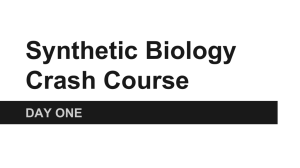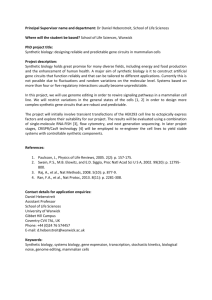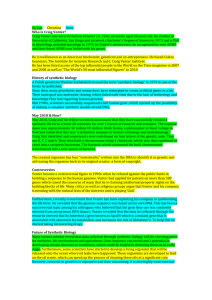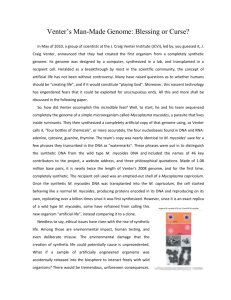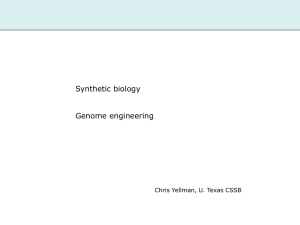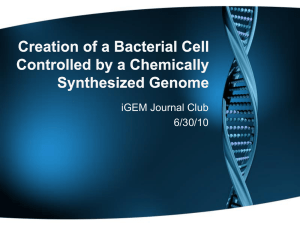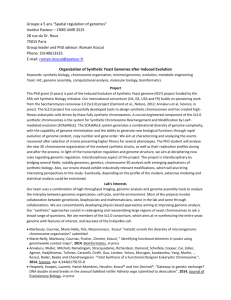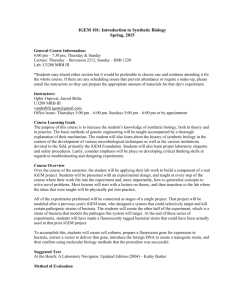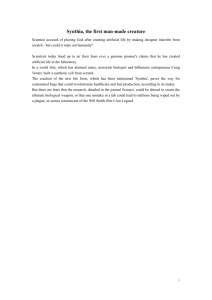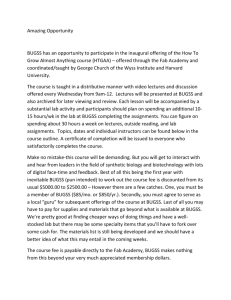KTSynthetic Biology Introduction
advertisement
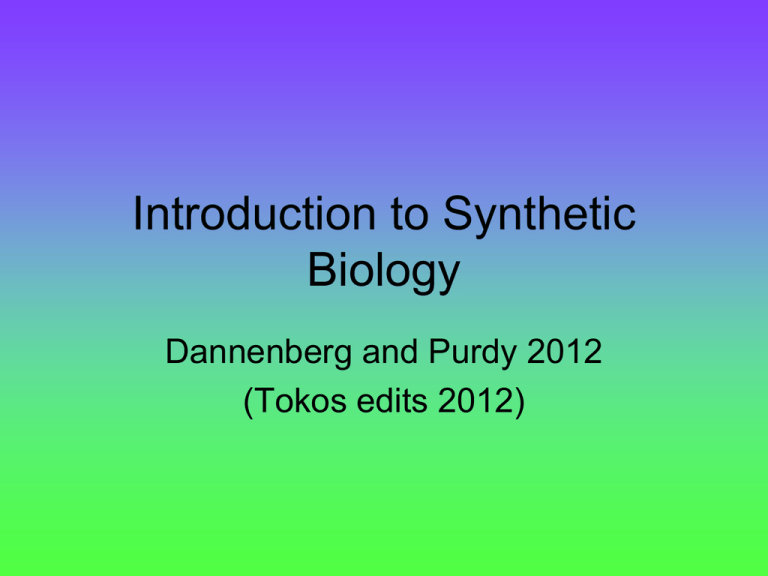
Introduction to Synthetic Biology Dannenberg and Purdy 2012 (Tokos edits 2012) What is Synthetic Biology? • https://www.youtube.com/watch?v=rD5uN AMbDaQ ELECTRICAL engineering solution MECHANICAL engineering solution water = weight water<weight BIOLOGICAL engineering solution BIOLOGICAL engineering solution Genetic Engineering rDNA Sequencing PCR A LIVING HOUSE Terreform’s Fab Tree Hab • How is Synthetic Biology Different? Synthetic biology uses four principles not typically found in genetics, genomics, or molecular biology: abstraction, modularity, standardization, and design and modeling. Abstraction: • Abstraction - you can use parts/devices/systems without having to worry about how they work. • DNA makes parts. • Parts into devices. • Devices connected to make systems. Modularity: • parts, devices and systems connected as self-contained units and combined in any combination you want Standardization: • All the “Tab A’s” fit into all the “Slot B’s.” • An everyday example - all light bulbs fit into any socket! Designing and modeling • build a model • test the devices capacity – improves design – tests basic biological assumptions that could be false Registry of Standard biological Parts • http://partsregistry.org/Main_Page DNA is DNA • E. Coli is our chassis – Can use parts from any organism – Can use parts made by a computer Abstraction Hierarchy a human invention designed to assist people in engineering complex systems Assemblies of devices make a system Assemblies of parts make up devices Sequences of DNA encode “parts” “Part” – sequence of DNA with human defined function AAAATGCACCCGCTGTCGATCAAACGCGCGGTGGCGAATATGGTGGTCAACGCCGCCCGT TATGGCAATGGCTGGGTCAAAGTCAGCAGCGGAACGGAGCCGAATCGCGCCTGGTTCCA GGTGGAAGATGACGGTCCGGGAATTGCGCCGGAACAACGTAAGCACCTGTTCCAGCCGT TTGTCCGCGGCGACAGTGCGCGCACCATTAGCGGCACGGGATTAGGGCTGGCAATTGTGC AGCGTATCGTGGATAACCATAACGGGATGCTGGAGCTTGGCACCAGCGAGCGGGGCGGG CTTTCCATTCGCGCCTGGCTGCCAGTGCCGGTAACGCGGGCGCAGGGCATGACAAAAGA AGGGTAATCTAGAGGCATCAAATAAAACGAAAGGCTCAGTCGAAAGACTGGGCCTTTCGT TTTATCTGTTGTTTGTCGGTGAACGCTCTCCTGAGTAGGACAAATCCGCCGCC Parts assembled into Devices AAAATGCACCCGCTGTCGATCAAACGCGCGGTGGCGAATATGGTGGTCAACGCCGCCCGT TATGGCAATGGCTGGGTCAAAGTCAGCAGCGGAACGGAGCCGAATCGCGCCTGGTTCCA GGTGGAAGATGACGGTCCGGGAATTGCGCCGGAACAACGTAAGCACCTGTTCCAGCCGT TTGTCCGCGGCGACAGTGCGCGCACCATTAGCGGCACGGGATTAGGGCTGGCAATTGTGC AGCGTATCGTGGATAACCATAACGGGATGCTGGAGCTTGGCACCAGCGAGCGGGGCGGG CTTTCCATTCGCGCCTGGCTGCCAGTGCCGGTAACGCGGGCGCAGGGCATGACAAAAGA AGGGTAATCTAGAGGCATCAAATAAAACGAAAGGCTCAGTCGAAAGACTGGGCCTTTCGT TTTATCTGTTGTTTGTCGGTGAACGCTCTCCTGAGTAGGACAAATCCGCCGCC Parts assembled into Devices AAAATGCACCCGCTGTCGATCAAACGCGCGGTGGCGAATATGGTGGTCAACGCCGCCCGT TATGGCAATGGCTGGGTCAAAGTCAGCAGCGGAACGGAGCCGAATCGCGCCTGGTTCCA GGTGGAAGATGACGGTCCGGGAATTGCGCCGGAACAACGTAAGCACCTGTTCCAGCCGT TTGTCCGCGGCGACAGTGCGCGCACCATTAGCGGCACGGGATTAGGGCTGGCAATTGTGC AGCGTATCGTGGATAACCATAACGGGATGCTGGAGCTTGGCACCAGCGAGCGGGGCGGG CTTTCCATTCGCGCCTGGCTGCCAGTGCCGGTAACGCGGGCGCAGGGCATGACAAAAGA AGGGTAATCTAGAGGCATCAAATAAAACGAAAGGCTCAGTCGAAAGACTGGGCCTTTCGT TTTATCTGTTGTTTGTCGGTGAACGCTCTCCTGAGTAGGACAAATCCGCCGCC Device to System Plasmids and Transformation Now for the Good Part (2009 Cambridge iGEM Team) The Problem • Toxins contaminate the environment • Detection can be expensive and complicated • Can cheap bacteria be used as toxin indicators that change color in response to toxin levels? The Color-Generating Device • Contain violacein pigment devices (ORF from Chromobacterium violacein) Genes re-engineered to produce purple and green in E. Coli • If all 5 genes in the ORF are expressed - purple pigment produced • If third gene in ORF sequence is removed - green pigment produced The Chassis • To a Synthetic Biologist = Escherichia coli Bacterial transformation of Escherichia coli • Two different strains of E. coli (4-1 & 4-2) • Two different plasmids (pPRL & pGRN) • Can we expect the devices to behave the same in each strain, or will the chassis have an effect on the intensity of color produced? Creation of a Bacterial Cell Controlled by a Chemically Synthesized Genome Dan Gibson, +21, Ham Smith and Craig Venter Science (2010) 329: 52 M. mycoides genome transplanted to M. capricolum PCR for watermarks Creation of a Bacterial Cell Controlled by a Chemically Synthesized Genome Dan Gibson, +21, Ham Smith and Craig Venter Science (2010) 329: 52 Presidential Commission for the Study of Bioethical Issues New Directions: The Ethics of Synthetic Biology and Emerging Technologies December 2010
